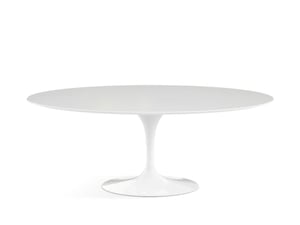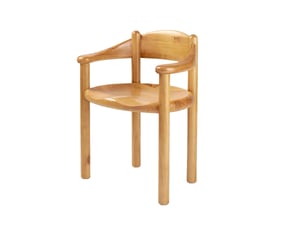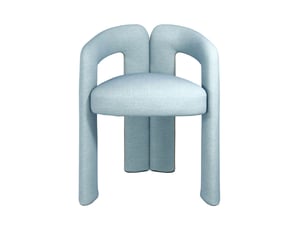How to design the dining area with iconic tables in marble, glass, and wood
In today’s kitchen, the table is more than a practical surface—it’s the centerpiece. It sets the atmosphere, anchors the design, and shapes how the room is experienced.
Whether sculptural or finely crafted, each piece reflects the vision of its designer, pairing high-quality materials with balanced proportions to transform the dining area into a space for daily life and connection.
The Tulip Table by Knoll, designed by Eero Saarinen in 1956, reimagined the traditional table base by replacing multiple legs with a single pedestal. This streamlined design creates a cleaner look and makes better use of space. Available in round or oval versions with marble or laminate tops, it works beautifully in bright, minimalist kitchens where ergonomics and functionality matter most.
The Table Tube d’Avion by Cassina, designed in 1929 by Le Corbusier, Charlotte Perriand, and Pierre Jeanneret, is a landmark of modern design. Its chrome tubular steel frame, drawing on engineering and aeronautics, reflects a stripped-back approach that prioritises function over ornament. Topped with glass or marble, it’s perfectly suited to spacious, uncluttered kitchens with a precise, understated aesthetic.
The CH327 Table by Hans J. Wegner for Carl Hansen & Søn is a quintessential example of Danish design. Made from solid wood with slender proportions and gently rounded edges, it exudes balance and understated elegance. In the kitchen, it brings an inviting, harmonious atmosphere, where honest materials and clean lines come together in quiet harmony.

The Epic Table by Gubi, designed by GamFratesi, is inspired by classical architecture. A cylindrical base in travertine or steel anchors a substantial round top, with each stone’s veining making every table unique. It lends the kitchen a grounded presence and enduring character—ideal for anyone who values the integrity of natural materials.
The Lagos Table by Baxter features a Patagonia marble top set on handcrafted metal legs. With each slab’s unique veining, every table is truly one of a kind. It’s well-suited to open kitchens and expansive spaces, where the centerpiece should combine material richness, lasting strength, and visual harmony with the surrounding décor.

The Maestro Table, designed by Gianfranco Frattini for Acerbis in 1997, strikes a balance between solidity and lightness. Its bridge-like frame of vertical wooden supports holds a rectangular top, finished in open-pore wood that brings out its natural texture. In the kitchen, it fits effortlessly into minimalist interiors characterised by clean proportions and refined materials.
The Sengu Table by Cassina, designed by Patricia Urquiola, is inspired by Japanese temple architecture. Solid wood legs are paired with marble or stoneware columns, while the top highlights the stone’s natural veining. Designed for gathering, it serves as a stable centerpiece that pairs beautifully with authentic materials and thoughtfully arranged spaces.
The 525 En Forme Libre Table, designed by Charlotte Perriand for Cassina in 1938, embraces freedom of form. Its asymmetrical top with fluid lines rests on cylindrical legs, departing from strict symmetry. Perfect for casual, free-flowing kitchens, it encourages easy movement and accessibility while offering a distinctly unconventional look.

The Tria Table by Lorenza Bozzoli for Ghidini 1961 is topped with an irregular marble surface inspired by water-smoothed pebbles, set on a solid, well-proportioned metal base. It’s an eye-catching addition to contemporary dining spaces, where the table becomes a defining element that balances function, presence, and refined materials.
The Florence Table, designed by Florence Knoll for Knoll in 1961, is defined by simplicity and precision. A steel frame supports a marble or glass top, giving it a clear, refined aesthetic. It’s ideal for modern kitchens where worktops extend seamlessly into the dining area, creating visual continuity and a cohesive look.
The dining space is ultimately defined by a central design piece—one that sets the tone and brings people together. With the Mohd Interior Design Service, every choice contributes to a bespoke project, where top international brands are shaped around your personal vision. The result is a dining area that feels harmonious, distinctive, and enduring—a reflection of refined, mindful living.
We turn your inspiration into a project
We help you shape your home, collecting the best inspirations for you and editing design selections that fit your space and needs.

















































